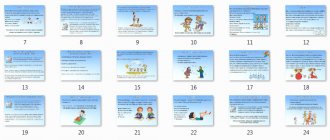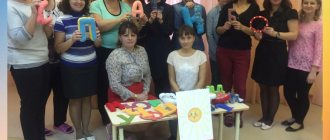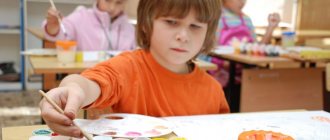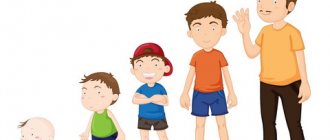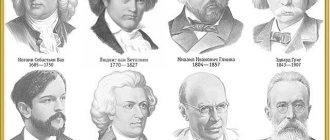Innovation for children is an introduced innovation that provides a better and more progressive learning process. Innovative games are created on the basis of innovative developments and ideas. The production is carried out by the well-known Russian company, which began its activities in 2004. The company's products are made only from natural raw materials and have all the required quality certificates.
Directions for innovative development of children
At the present stage of development of education in the Russian Federation, the need has arisen to introduce innovations into the learning process. There is a need to improve the level of preschool and school education. The main goal is to identify and develop creative abilities in schoolchildren. The introduction of innovation helps to reveal the inner potential and identify the abilities of children.
Important. Innovations for children will help in preschool education, and in the future they will help to identify abilities in the exact sciences or humanities.
Popular innovative games for children
Interactive children's sandbox
It is a training complex for the best development. The sandbox consists of a laptop, a wooden structure, a projector and a depth sensor. The image on the sand may change; to do this, you must select the appropriate mode. With the help of the sandbox, educational and psychological classes are held that comply with the educational standard of the Russian Federation.
The sandbox has four modifications:
• islet;
• clearing;
• house;
• diamond.
The sandbox is a leader among innovative developments. During classes, children play with sand, which allows them to develop fine motor skills and relieve stress. Sandbox activities help develop: thinking, imagination, memory, attention and speech.
Interactive complex for children “Play and develop”
Developmental complex - an innovation for preschool children. Modern children are quite familiar with computers, many use them every day. Using the complex, you can conduct training in a playful way. Preschoolers remember better, use and develop muscle memory. Using the monitor's touch screen, kids can play various games. Innovation will help teach people how to cross the road correctly and start learning foreign languages. The main feature of the innovation is the learning process while playing.
"Big Chemical Laboratory"
A fun innovation for kids. The game consists of chemical elements, laboratory equipment, and necessary reagents. Kids get acquainted with chemical reactions and see the interaction of reagents. The learning process will become interesting and informative.
Set "Fire, water and copper pipes"
• Consists of 22 exciting experiences. The innovative game will allow you to learn a lot of new and interesting material.
• Fire and Water. Children will learn in detail about the interaction of the two elements.
• An unpredictable ending to innovative experiments that will amaze not only schoolchildren, but also adults.
The innovative set is safe, but it is better when schoolchildren study under the supervision of elders. Conducting experiments is quite interesting and exciting, so parents will not be bored. The main advantage of all components is natural material, it is non-toxic and harmless.
With this innovative game, children will gain interesting knowledge and skills.
Innovative kit “Young Perfumer”
Created for lovers of fragrances and travel. The young chemist will be able to reproduce the best aromas of Italy and recognize the popular smells of Venice and Tuscany. To do this, you need to correctly mix several components from the innovative set. The finished perfume can be used independently or given to close friends. Thus, children will feel like real creators of exclusive fragrances.
Main features of the set:
• it is possible to create any signature perfume at home;
• a professional set will allow you to mix different oils and allow you to plunge into the world of perfumes;
• the instructions describe in detail all stages of perfume production;
• innovation will make it possible to create more than 25 popular flavors of Italy.
• such activities contribute to the future choice of profession.
Innovation for children, set “Candle Studio. Sea Mystery"
Using the play set you can create scented gel candles. The set includes: multi-colored decorative sand, glass glasses, accessories, decorations and gel used for combustion.
The game will help develop hand motor skills; its components are absolutely safe. The candle will become an interior decoration or a good gift.
Set for making exclusive soap “Soap Workshop”
It will help to interest schoolchildren in such experiments. Helps develop motor skills and perseverance. Parents can spend more time with their children conducting experiments. After experiments, you get beautiful figures from natural soap. Soap can be stored in the bathroom; it will remind you of the work done and motivate you to further experiments.
The game includes the following components:
• glasses for soap base;
• natural dyes and flavors;
• ceramic bowl;
• soap mold;
• chopsticks and gloves.
Innovation for children, set “Colored polymer slimes”
Thanks to chemical experiments, children create new bright toys. The game will entertain and put you in a cheerful mood. During the experiment, kids will see how multi-colored slimes and worms appear. This will attract further educational research, as well as arouse interest in chemistry and the environment. Promotes motor development.
Young chemists will make their own toys to play with. Joy will have no boundaries.
The composition is absolutely safe and includes the following components: colored solution, worm activator, container for liquids, pipette, measuring spoon and gloves.
Innovation for children, “Taming the Fire” set
The experiments will involve fire, so children should not be left alone, without parental supervision. Young chemists will gain a lot of new knowledge during the game. Experiments will make it possible to learn about the laws of the elements, and schoolchildren will learn to assimilate new and necessary information.
The house will turn into a laboratory where fire will be tamed. The game includes 6 experiments, consists of the necessary reagents, laboratory equipment and detailed instructions for use.
Interactive technologies in kindergarten
Today, in order to keep up with the times and constantly improve their teaching skills, kindergarten teachers have to use a complex of various developmental techniques and all their imagination. Educational standards provide for the use of various types of children's activities that the teacher must use to solve pedagogical problems. The authoritarian pedagogical style is a thing of the past; preference is given to democratic interactive technologies, implying multilateral communication, effective methods and methods of close interpersonal interaction based on dialogue, cooperation, and mutual understanding.
Interactive technologies are a set of pedagogical methods aimed at building the educational process in conditions of effective interaction.
Interactive technologies can be expressed in various forms:
- Individual (the child, with the help of the teacher, solves the problem himself, option – “child - computer”),
- Steam room (child-child interaction),
- Group (work in subgroups),
- Collective (active frontal work),
- Planetary (solving assigned problems by subgroups and choosing the optimal option).
Advantages of interactive technologies:
- Preschoolers develop individual personal conditions for self-development;
- Speech activity develops;
- Interpersonal relationships develop;
- Skills of playing in a team based on moral standards are developed;
- Children become aware of their personal intellectual worth;
- The psychology of success is being formed.
The implementation of interactive technologies in preschool educational institutions is possible subject to the conditions of comfortable cooperation between the teacher and preschoolers, motivation in solving the task, and the use of vivid images, examples, and objects.
Particular attention in the pedagogical process is paid to creating a comfortable creative environment and awareness of the intellectual competence of students. In an atmosphere of goodwill and support, within the framework of close interaction, free communication on equal terms, the preschooler feels personal success and the learning process becomes more productive. Interactive technologies are designed to make the learning process not just interconnected, but also more exciting and creative.
The introduction of interactive technologies in kindergarten is carried out in stages, taking into account age characteristics, for example:
- Younger age group: play in pairs, “children’s circle”,
- Middle age group: game in pairs, round dance, carousel, chain;
- Older age group: work in pairs, “children’s circle”, carousel, chain, interview, lesson in small groups (threes), aquarium;
- Preparatory (pre-school) group: lesson in pairs, “children’s circle”, chain, carousel, interview, lesson in small groups, large children’s circle, tree of knowledge.
It is worth noting that the teacher, based on his experience, can experiment with forms of interaction, and, for example, introduce interviews in the middle group.
interactive methods help stimulate the diversified development of a preschooler . This concept consists of two components: “method”, as a way of interaction between “teacher and child” and “interaction” – intensive activity between participants in the process. Accordingly, interactive methods mean enhanced pedagogical interaction during the educational process.
Interactive methods can be discussion, game, complex:
- Role-playing game (theater production, fairy tale),
- Interactive game
- Business game,
- Case method (solving a problem situation),
- Discussion,
- Clusters (search for associations),
- Microphone (alternate statements),
- Debate (discussion of statements),
- Project method
- Brainstorming and others.
Examples of the use of interactive methods in different age groups of preschool educational institutions
Junior or II junior group: interactive method of working in pairs.
The teacher invites the children to find a partner or helps them break up in pairs, hold hands and look at each other. This can be done while sitting on the floor, on chairs, or standing. As a rule, at this age children already know each other's names. Each pair is asked to hold a toy, cube, or ball together. The teacher can hand over a bright object to each pair. He announces to the children that these toys are magical; whoever holds it in their hands smiles. When passing a toy to each other, you need to call your partner by name and smile. At the same time, the teacher himself must radiate affection and a smile and demonstrate action. Children are prone to imitations, they will repeat. Teaching practice will be successful if most of the children smile. Further, the teacher can complicate the rules: children change pairs, toys, give compliments, etc.
Middle group: interactive chain game. The teacher prepares a toy in advance - Luntik and tells the backstory: Luntik flew from the Moon, he knows Kuzya, Shershulya, Vupsen and Pupsen... the children help list the heroes of the fairy tale. Next, the task is set: besides the listed heroes, Luntik knows no one, he is not familiar with animals from fairy tales, he needs to be introduced. The teacher hands the Luntik figurine to one of the children and asks them to pass it further down the chain and name animals from different fairy tales, for example, a wolf from the fairy tale “The Wolf and the Seven Little Kids”, a bear from the fairy tale “Masha and the Bear”, “The Three Little Pigs”, “Puss in Boots” " and so on. Passing Luntik to each other, children introduce him to fairy-tale characters. If a preschooler is lost, then the teacher and the children on the left and right of the chain help remember fairy tales. In conclusion, the teacher can invite the children to fantasize about Luntik’s adventures in the land of fairy tales or to draw fairy-tale animals.
Senior preparatory group: comprehensive interactive lesson “My favorite kindergarten.” The teacher sets a task: the children need to prepare a presentation about what they like most about the kindergarten. Children are seated at tables in small groups of 3-4 people, with drawing kits on the tables. The teacher invites one group to discuss the topic of which toys are the most interesting in the group, the second group - which dish in the kindergarten is the most delicious, the third group - what interesting things can be seen during a walk, the fourth group - what they like most in a music lesson, and so on. Children in small groups discuss their options, draw on sheets of paper, and choose a representative from the group. The teacher approaches each group, helps with choices and resolves disputes. Next, representatives from each group take turns going to an improvised microphone and voice what exactly they like about the kindergarten, demonstrating the best drawing or several drawings from the group. The teacher, summing up, during a frontal discussion, based on the most interesting moments, composes a story about his favorite kindergarten, summarizes the information he heard, or offers to make a single presentation for children who want to speak at the microphone. You can place the pictures as visual cues and invite the children to write the story “My Favorite Kindergarten.”
Options for additional and main discussion topics: “The kindergarten of my dreams,” “My favorite activity in the kindergarten,” “Choice of a fairy tale for the children’s theater,” “The best gift for mom,” “Decorating the kindergarten,” etc.
Interactive pedagogical technologies are directly related to the use of interactive technical means. More and more children's institutions have high-tech equipment in the form of sensory boards, educational gaming computers, and interactive panels. Their use helps make the educational process more fun, interesting, and productive.
With the use of interactive technologies, the roles of the teacher and children change. The teacher's initiative decreases, the children's activity increases. Pedagogical skill lies in the ability to create comfortable psychological and practical conditions for the creative development of children, to overcome the threshold of shyness of some categories of pupils, for productive interaction and the success of the educational process.
If you found the information on the site useful, please share it on social networks:
more
